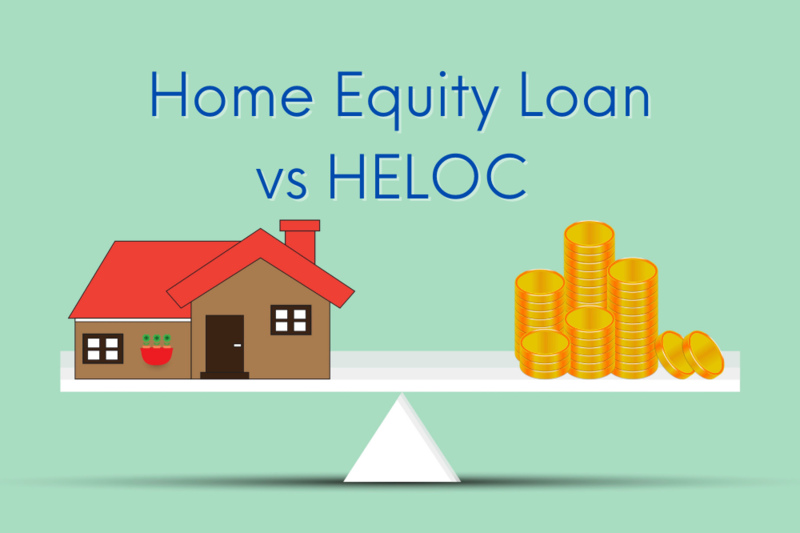Understanding HELOCs and Home Equity Loans
Mar 19, 2024 By Triston Martin
Popular options like the Home Equity Line of Credit (HELOCs) and home equity loans appeal to homeowners who seek financial leverage from their property's equity for diverse needs. Each presents its advantages and disadvantages. Discerning the subtle distinctions between them can empower you to make a knowledgeable choice aligning with your circumstances. This article embarks on an exploration of crucial divergences between HELOCs and home equity loans, aiming to guide you through the complexities inherent in these specific types of residential funding.
HELOC Overview
The Home Equity Line of Credit (HELOC) is a revolving line of credit. It allows homeowners to leverage their property's equity, much like using a credit card. With the HELOC, borrowers obtain an established credit limit and withdraw funds as necessary, not exceeding that set cap, over specific draw periods. These draw periods usually span around 5-10 years during which time they can access capital and initiate interest-only payments.
Furthermore, HELOCs frequently provide repayment option flexibility extending beyond the draw period. The conclusion of the draw period signals borrowers to enter into a repayment phase where they must settle their outstanding balance over typically 10-20 years. At this stage, borrowers might confront augmented monthly payments since they commence repaying both principal and interest on the loan.
- Caution: Be mindful of potential interest rate increases after the draw period ends, as this can lead to higher monthly payments during the repayment phase.
- Consideration: HELOCs can be advantageous for homeowners with fluctuating financial needs, allowing them to borrow only what they need when they need it, similar to a safety net.
Home Equity Loan Overview

On the other hand, a home equity loan, also known as a second mortgage, is a lump-sum loan that is disbursed to the borrower in one go. The loan amount is determined by the equity in the home, and borrowers receive the funds upfront. Unlike a HELOC, where borrowers can draw funds as needed, a home equity loan provides a fixed amount, which is repaid over a set term with fixed monthly payments.
Moreover, in comparison to HELOCs that may offer repayment periods of 20 years or more, home equity loans typically feature shorter terms ranging from 5 to 15 years. This condensed repayment period potentially escalates monthly payments. Nevertheless, it could also foster significant savings on interest throughout the loan's duration.
- Fact: Home equity loans may offer tax-deductible interest payments, making them an attractive option for certain borrowers seeking potential tax benefits.
- Noteworthy: Be aware of the potential risk of overborrowing with a home equity loan, as tapping into too much equity can strain your finances and put your home at risk of foreclosure.
Interest Rates and Terms
Comparing HELOCs and home equity loans necessitates an examination of the interest rates and repayment terms. Typically, variable interest rates tied to the prime rate characterize HELOCs. Thus, monthly payments may fluctuate in response to market conditions. Conversely, loan options for home equity frequently offer fixed interest rates. This ensures borrowers enjoy predictability and stability within their monthly payment commitments.
Understanding the factors influencing interest rates on HELOCs and home equity loans remains crucial. The prime rate established by the Federal Reserve significantly determines interest rates for HELOCs, with changes in it directly impacting loan interests. Contrastingly, broader economic factors like inflation rates and market demand for fixed-rate securities influence interest rates of home equity loans.
- Consideration: Consider opting for a HELOC if you anticipate interest rates to decrease in the future, as variable rates can offer savings when market rates decline.
- Caution: Keep in mind that while fixed-rate home equity loans offer stability, they may come with higher initial interest rates compared to HELOCs, especially when market interest rates are low.
Flexibility and Accessibility
The primary advantage a HELOC offers is its inherent flexibility. During the draw period, borrowers can access funds as required. This makes it particularly suitable for ongoing expenses or projects where costs are uncertain. Furthermore, HELOCs allow multiple repayments and drawings within the draw period, a truly versatile option that provides an ever-revolving source of credit.

Conversely, home equity loans present an ideal option for singular expenses such as home renovations or debt consolidation. They provide a lump sum upfront. Although the flexibility of a HELOC may not be available, home equity loans compensate with predictability in terms of repayment. Over the loan term, fixed monthly payments are maintained.
- Fact: Some lenders may offer HELOCs with options for converting all or a portion of the outstanding balance to a fixed-rate loan, providing borrowers with additional flexibility and stability.
- Noteworthy: When considering a home equity loan, ensure that you have a clear plan for utilizing the funds, as borrowing a lump sum without a specific purpose can lead to unnecessary debt burden and financial strain.
Risk and Considerations
HELOCs and home equity loans, both leverage your home's equity which is a mechanism that secures them with the property. This provision of collateral typically yields lower interest rates, in comparison to unsecured loans. However, it introduces a potential risk for homeowners. If you default on either a HELOC or home equity loan, foreclosure becomes an imminent threat. Thus, jeopardizing the safety of your residence.
You must critically evaluate your financial situation, risk tolerance, and borrowing needs when determining the superior option for you. If ongoing expenses necessitate flexibility, then a HELOC may offer a more advantageous choice. Conversely, if you harbor specific projects or expenses and value predictable monthly payments over all else; it is possible that opting for a home equity loan could be better suited to your needs.
- Caution: Carefully evaluate your ability to repay the borrowed funds, considering potential changes in your financial circumstances, such as job loss or unexpected expenses.
- Consideration: Keep in mind that while both HELOCs and home equity loans use your home as collateral, defaulting on a HELOC may have less severe consequences compared to defaulting on a home equity loan, as the latter involves a lump-sum repayment obligation.
Conclusion
Both HELOCs and home equity loans, in conclusion, present a method for homeowners to utilize their property's equity to meet diverse financial requirements. Differentiating between the two can empower you with an optimal choice that harmonizes your fiscal goals and situation. Opting for either a HELOC or home equity loan necessitates responsible borrowing. It is imperative to go over the potential long-term effects of leveraging your house's value as financing.
-
 Know-how May 14, 2024
Know-how May 14, 2024A Comprehensive Guide to What Is 702(j) Retirement Plan and How it Works?
Do you want to know about 702(j) retirement plans? Dive into this guide to understand what they entail, and how they function to secure your financial future.
-
 Know-how Oct 28, 2023
Know-how Oct 28, 2023How To Apply For Rent Assistance, Along With A Fallback Strategy
Congress has approved more than $46 billion in emergency relief to cover unpaid rent and energy bills for those having trouble making ends meet. You may or may not get any of the promised funds. Not all renters who have fallen behind on their rent will be able to receive help. Additional paperwork may be required in some countries, which adds another possible hurdle to getting the money
-
 Know-how Nov 23, 2023
Know-how Nov 23, 2023Guide to 'Buy Now, Pay Later' Apps: Which One's Right for You?
Buy now, pay later (BNPL) applications are popular for financing clothing, presents, and home furnishings. Discover the best 6 apps to use the BNPL method.
-
 Know-how Nov 23, 2023
Know-how Nov 23, 2023Investing for the Long Haul: Why Timing Isn't Everything
Investors must understand why long-term investing trumps market timing. To know the difference between the two and why one outperforms the other, read this guide.
